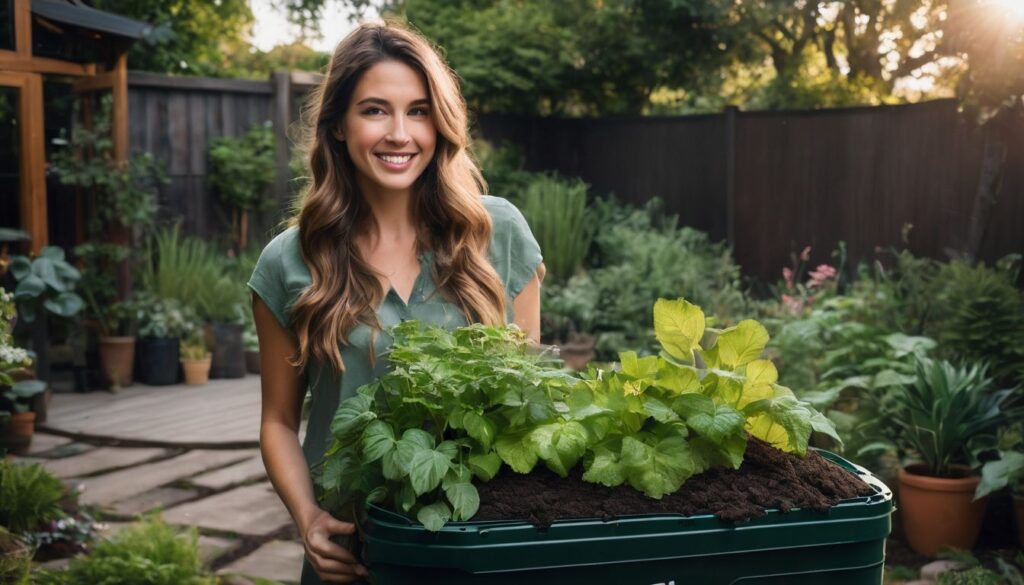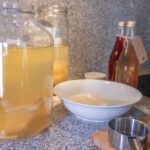Are you tired of nudging your overflowing trash can, crammed full of food scraps and garden refuse? The surprising fact is that our kitchens and yards produce over 28 percent of household waste! This blog will introduce you to the magic of composting at home – a green thumb strategy which not only helps in effective waste management but also improves soil health.
Discover practical ways on how to compost at home with a compost bin. Ready for some dirt-digging fun?.
Key Takeaways
- Composting at home with a compost bin reduces landfill waste and helps in effective waste management.
- It improves soil condition, making it more fertile and allowing for better plant growth.
- Composting recycles kitchen and yard waste, turning them into nutrient-rich soil.
- It introduces beneficial organisms to the soil, creating a healthy ecosystem for plants.
- Composting at home also helps fight climate change by reducing harmful methane gas emissions.
Compost at Home With a Compost Bin and Its Benefits

Composting at home offers numerous benefits, including reducing landfill waste, improving soil condition, recycling kitchen and yard waste, introducing beneficial organisms to the soil, and helping fight climate change.
Reduces landfill waste

Composting at home cuts down on landfill waste. Food scraps and yard waste are more than a quarter of what we throw away. So, by composting them, our trash cans get less full. It also helps the earth! Less stuff in landfills means less harmful gases like methane.
Making compost at home is a green way to manage organic waste from the kitchen and garden.
Improves soil condition

Composting at home with a compost bin can greatly improve the condition of your soil. When you add compost to your garden, it adds valuable nutrients that help plants grow. The organic matter in compost improves soil structure, making it more friable and allowing for better root growth.
Compost also enhances the water-holding capacity of the soil, reducing the need for frequent watering. In addition, compost contains beneficial microorganisms that break down organic matter and release nutrients into the soil, creating a healthy ecosystem for plants to thrive.
By improving soil condition through composting, you can have healthier and more productive gardens while reducing waste and helping the environment.
Recycles kitchen and yard waste

Composting is a great way to recycle kitchen and yard waste, reducing the amount of waste that ends up in landfills. By composting food scraps like fruit peels and vegetable trimmings, as well as yard waste like leaves and grass clippings, you can turn these organic materials into nutrient-rich soil.
This not only keeps valuable resources out of the landfill but also helps improve soil condition and introduces beneficial organisms that contribute to plant growth. Composting kitchen and yard waste is an easy and environmentally friendly way to make a positive impact while reducing your carbon footprint.
Introduces beneficial organisms to the soil

Composting at home with a compost bin introduces beneficial organisms to the soil. These organisms, like bacteria and fungi, break down organic matter into nutrient-rich compost. This compost is then added to the soil, improving its fertility and structure.
The beneficial organisms help decompose organic waste efficiently, releasing essential nutrients that plants need for growth. By introducing these helpful creatures into the soil through composting, you can create a healthier environment for your plants and promote sustainable gardening practices.
Helps fight climate change

Composting is not only good for the environment but also helps fight climate change. When we compost our kitchen and yard waste instead of sending it to landfills, we reduce the amount of methane gas that is released into the atmosphere.
Methane is a potent greenhouse gas that contributes to global warming. By composting, we can help decrease these harmful emissions and make a positive impact on our planet’s health.
So, let’s start composting at home and do our part in fighting climate change!
What to Compost in a Compost Bin

You can compost food scraps and yard waste like leaves and grass clippings in a compost bin, but it’s important to avoid putting meat, dairy, oily or greasy items in the bin.
Food scraps

One important component of composting at home is using food scraps. Instead of throwing them away in the trash, you can turn your kitchen leftovers into nutrient-rich compost for your garden.
Food scraps like fruit peels, vegetable trimmings, coffee grounds, and eggshells are perfect for composting. These organic materials provide essential nutrients to the soil once they break down.
Just make sure to avoid putting meat, dairy products, and oily or greasy items in your compost bin as they can attract pests or create unpleasant odors. By composting food scraps, you’re not only reducing waste but also creating a sustainable way to nourish your plants and contribute to a healthier environment.
Yard waste (leaves, grass clippings)
-92423354.jpg)
To compost yard waste such as leaves and grass clippings, simply add them to your compost bin. These materials are considered “brown” or carbon-rich materials, which provide structure to the compost pile.
They help balance out the nitrogen-rich “green” materials like food scraps. As your yard waste breaks down, it adds nutrients to the finished compost. Remember to chop or shred larger pieces of yard waste before adding them to speed up the decomposition process.
Avoid certain items (meat, dairy, oily or greasy items)
-92423505.jpg)
When composting at home with a compost bin, it’s important to avoid certain items like meat, dairy, oily or greasy items. These things can attract pests and create unpleasant odors in your compost.
They also take longer to break down and can disrupt the balance of your compost mix. Stick to adding food scraps like fruits and vegetables, along with yard waste such as leaves and grass clippings.
By avoiding these specific items, you’ll ensure that your compost remains healthy and effective for improving soil condition and reducing landfill waste.
How to Set Up and Maintain a Compost Bin

Choose the right compost bin and create a healthy compost mix with the proper carbon/nitrogen ratio, while also properly storing compost in the kitchen.
Choose the right compost bin

To start composting at home, it’s important to choose the right compost bin. There are different options available, such as tumblers, bins, and DIY compost bins. Consider the size of your yard or garden and the amount of waste you generate.
If you have limited space, a tumbler or enclosed bin may be more suitable. For larger gardens, you can opt for a traditional open bin or build your own DIY compost bin using materials like wood pallets or wire mesh.
The key is to ensure that the chosen compost bin allows for proper aeration and drainage while keeping pests out.
Create a healthy compost mix (carbon/nitrogen ratio)
-92423210.jpg)
To create a healthy compost mix, you need to balance the carbon and nitrogen ratio. Carbon-rich materials include dry leaves, straw, sawdust, and paper. Nitrogen-rich materials include food scraps, grass clippings, and coffee grounds.
Aim for a ratio of 3 parts carbon to 1 part nitrogen. This helps break down the organic matter efficiently and prevents unpleasant odors. Mix the materials together well to ensure proper decomposition.
By maintaining a balanced compost mix, you’ll have nutrient-rich compost for your garden in no time! Remember that composting is a natural process that takes time and patience.
Properly store compost in the kitchen
To properly store compost in the kitchen, you will need a suitable container. Choose a small countertop bin or pail with a tight-fitting lid to prevent odors and pests. Line the container with newspaper or compostable bags for easy cleanup.
Place it in a convenient spot near where food waste is generated, like your sink or prep area. Make sure to add carbon-rich materials, such as shredded paper or dry leaves, to absorb moisture and control odors.
Empty the container regularly into your outdoor compost bin to continue the composting process and minimize smell in your kitchen.
Use different composting methods (no-turn, enclosed bins, tumblers)
There are different methods you can use to compost at home with a compost bin. One method is called “no-turn” composting, where you simply add your kitchen and yard waste to the bin and let it decompose without turning it over.
This is an easy and low-maintenance approach.
Another method involves using enclosed bins or tumblers. These bins have lids that help trap heat and moisture, which speeds up the decomposition process. You can easily turn the contents of these bins by rotating them or flipping them over, allowing for better aeration and quicker breakdown of materials.
No matter which method you choose, it’s important to regularly check the moisture level in your compost bin and make sure it stays damp but not soggy. This will help create ideal conditions for decomposition.
Troubleshooting common composting problems (soggy compost, clumping, pest control)
Here are some common composting problems you may encounter and how to troubleshoot them:
- Soggy compost:
- Soggy compost can occur if there is too much moisture in the bin.
- To fix this, add dry materials like leaves or shredded paper to absorb the excess moisture.
- Make sure to turn the compost regularly to increase aeration and prevent waterlogged conditions.
- Clumping:
- Clumping happens when organic materials stick together and don’t break down properly.
- To prevent clumping, make sure to mix your compost regularly with a pitchfork or shovel.
- Adding brown materials like dried leaves or shredded newspaper can help improve airflow and prevent clumping.
- Pest control:
- If you notice pests like fruit flies or ants in your compost bin, it’s important to address the issue promptly.
- Keep your compost covered with a lid or tarp to deter pests from getting inside.
- Avoid putting meat, dairy, or oily/greasy items in your compost bin as these can attract pests.
- If necessary, use natural pest control methods such as diatomaceous earth or vinegar solutions to discourage insects.
Using Finished Compost and Benefits

Using finished compost in gardening enhances plant growth and nutrition by providing essential nutrients and improving soil structure.
Determine when compost is ready to use
Compost is ready to use when it has turned into a dark, crumbly material that resembles soil. This process can take anywhere from two months to a year, depending on various factors like temperature and the materials used.
To check if your compost is ready, look for signs such as an earthy smell and the absence of recognizable food scraps or yard waste. You can also perform a simple test by placing a handful of compost in a sealable bag for a few days – if there’s no mold or unpleasant odor, then it’s good to go! Using finished compost in your garden helps improve soil structure, provides essential nutrients to plants, and promotes healthier growth overall.
How to use compost in gardening
Using compost in gardening is easy and beneficial. Here are some ways to use compost in your garden:
- Spread a layer of compost on top of the soil around your plants.
- Mix compost into the soil before planting flowers, vegetables, or shrubs.
- Make a compost tea by steeping compost in water and using it to water your plants.
- Use compost as mulch to help retain moisture and suppress weeds.
- Create a compost pile or trench in your garden to nourish the soil over time.
Enhances plant growth and nutrition
Composting not only helps reduce waste and improve soil condition, but it also enhances plant growth and nutrition. When compost is added to the garden, it provides essential nutrients that plants need to thrive.
The organic matter in compost improves soil structure, allowing roots to access water and nutrients more easily. This leads to stronger and healthier plants with larger yields. Additionally, compost can increase the microbial activity in the soil, which further benefits plant growth.
With regular application of compost, you’ll notice improved plant health and a bountiful harvest from your garden.
Conclusion

Composting at home with a compost bin is an easy and beneficial way to reduce waste, improve soil health, and fight climate change. By following simple steps like choosing the right compost bin, knowing what to compost, and maintaining the compost mix properly, anyone can start composting.
So grab a bin, gather your food scraps and yard waste, and create nutrient-rich compost for your plants while helping the environment!
FAQs
1. What is home composting?
Home composting is a form of organic waste management where green material and kitchen scraps are turned into rich, healthy soil in a compost bin.
2. How do I start my own DIY composting at home?
You can start by getting a garbage can, bucket or other storage options for your backyard. Then simply add layers of burlap and kitchen scraps to make layer cake composting.
3. Are there any tips for beginners with trouble in active composting?
Yes! Key to successful home Composting lies in balancing the mix of ‘green’ material – which adds nitrogen, with ‘brown’ materials – that adds carbon.
4. What are the benefits of having a compost bin at home?
The benefits include reducing household waste while creating nutrient-rich soil for plants through this organic waste management technique.
5. Can all kitchen scraps be used when I try to learn how to compost at home with a compost bin?
No – not everything you throw away can be used in your backyard; However, most fruit and vegetable peelings along with eggshells and coffee grounds are perfect additions.

As a dedicated mother and passionate software developer, she weaves her diverse experiences into captivating stories that inspire and engage readers. Emma's love for sustainable living and environmental consciousness permeates both her personal and professional life. When she's not immersed in the world of coding and software development, Emma can be found nurturing her family and tending to her thriving organic garden. Her commitment to sustainable practices extends to every aspect of her life, from repurposing household items to embracing eco-friendly technologies.










